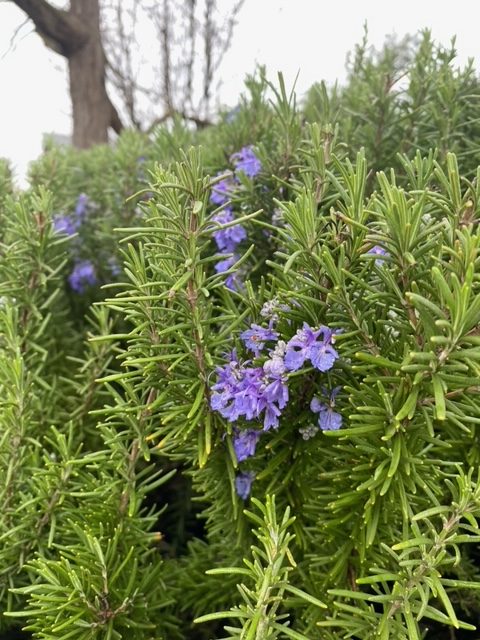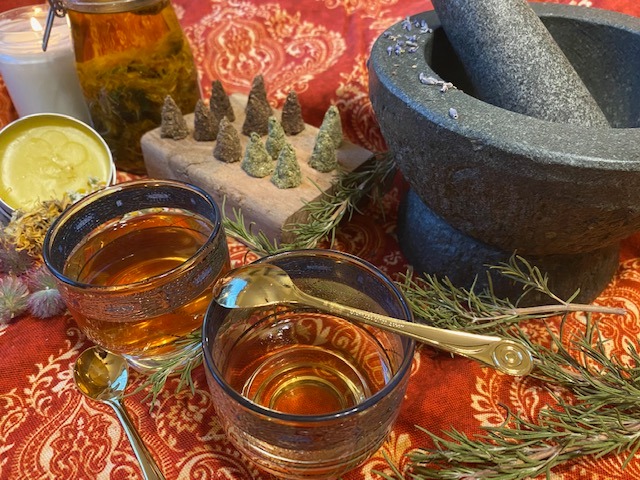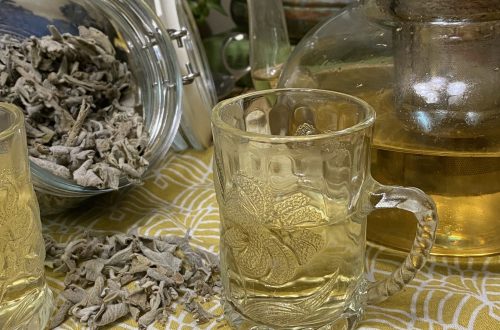Rosemary is currently coming into flower here in Sacramento. This means the plant is actively growing and is filled with wonderful aromatic oils that are at their peek concentration. This makes it an excellent time to harvest rosemary for culinary purposes. I will add, that since our region allows for rosemary to be viable all year long, you can of course harvest and use fresh rosemary 12 months out of the year here. However I also like to have dried rosemary to use in teas and for making incense, and early Spring is the perfect time to harvest for this purpose.
Harvesting
When harvesting rosemary, choose a branch that has not flowered yet. A good practice is to keep your cuts close to the tips of the branches. Depending on the age and size of your rosemary plant, this length can vary from a mere inch up to 8-10″. You’re looking to take cuttings in the soft green stems and avoid cutting too far down the stem into the old wood. Use sharp scissors or pruning shears and be sure not to remove too much from any one plant. A good rule of thumb when pruning any plant is to avoid removing more than 20-30% of the total foliage at any one time.

Different Varieties – There are numerous varieties and cultivars of rosemary (Rosmarinus officinalis), each with its own unique characteristics, including variations in growth habit, leaf and flower color, and aromatic profiles. At The Secret Garden we grow Prostratus Rosemary, which is a low-growing variety, over by the chicken coop. The strong scent of the rosemary can help repel poultry specific pests like mites and lice, but we especially like that the aroma helps camouflage the not-so-lovely smell of our wonderful chickens! Jasmine grows Tuscan Blue Rosemary at her home, which has been specifically cultivated for its robust flavor profile. This variety grows quite tall, up to 5-6′, and the stems are so robust that you can actually strip the leaves, soak the stems and use them as shish kabob skewers!

Drying
You don’t need any fancy equipment to dry your rosemary. Simply gather a few sprigs and tie together at the stems with a rubber band or kitchen string. If you have a lot to dry, make lots of little bundles rather than large ones. This will ensure that there is good air circulation into the center of the bundle so each sprig dries thoroughly and nothing develops mold. Hang your bundles in a dark place like a kitchen pantry, or simply place in a brown paper bag. Allow them to dry until each little rosemary needle is completely brittle, this may take anywhere from a few days to a few weeks depending on amount being dried and temperature/humidity levels. Once completely dry, run your fingers down the stem (from the tip to where it was cut) and all the individual needles will come off easily. If you have a dehydrator, the drying process can be done in matter of a few hours.

Storing
Once dry you can store your rosemary needles in an airtight jar in your kitchen pantry, or you can submerge needles in oil and store in the freezer. Ice cube trays or silicone molds are a great way to create small portions that, once frozen solid, can then be popped out of the molds and stored in freezer bags.
Health Benefits to Rosemary Consumption
- Rosemary contains antioxidants, such as rosmarinic acid and carnosic acid, which help to neutralize free radicals in the body.
- Rosemary has anti-inflammatory properties attributed to compounds in rosmarinic acid and ursolic acid. These properties can help reduce inflammation in the body.
- Some studies suggest that rosemary may have cognitive benefits. The aroma of rosemary has long been associated with improved memory performance and alertness.

Uses
Now that you’ve harvested and stored your rosemary, here are several fun ideas of ways to incorporate this wonderful herb into your diet and life. FYI, when using your dried rosemary, factor in that 1 tablespoon fresh rosemary needles equals 1 teaspoon dried rosemary.
- Rosemary Infused Olive Oil
- Rosemary Roasted Vegetables
- Rosemary Marinade for chicken
- Rosemary Herb Butter
- Rosemary Infused Water (hot or cold)
- Rosemary Salt
- Rosemary Lemonade
- Rosemary Focaccia Bread
- Rosemary Pesto
- Rosemary Cone Incense
If you want any tips on how to prepare any of these please let me know; and if you have a favorite use for rosemary that I haven’t mentioned, I do hope you’ll share! Happy growing, drying and storing!



